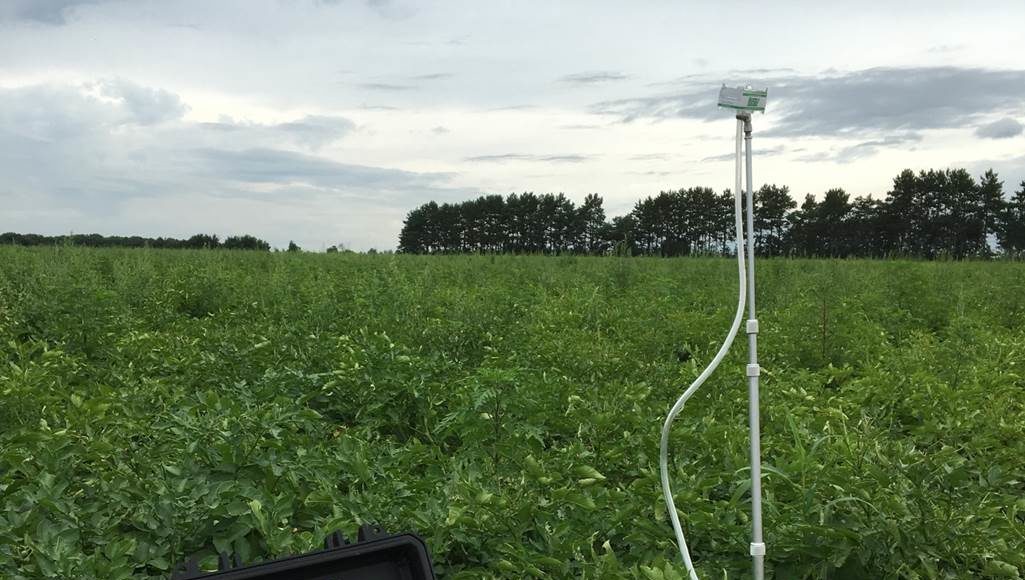[deck]Another tool in managing potato late blight.[/deck]
Determining late blight presence and disease pressure on the potato crop is an ongoing challenge. A heavy late blight infestation can cause several thousands of dollars in losses.
Control of late blight is mostly achieved through fungicide application, and growers anticipate that late blight control requires routine applications of fungicides at high rates and short intervals throughout the growing season, beginning at 50 per cent emergence. This is an unsustainable situation that is now being questioned.
A more rational approach, based on measured data such as the amount of pathogen in the air and the probability of infection by the pathogen based on weather conditions, could help growers, specialists and industry consultants to use fungicides more efficiently (only when needed) and to reduce the number of applications. Having another tool to predict late blight presence and its intensity in a field could be a crop saver for growers.
The use of predictive models based on environmental data is important, but the risk index based on spore counts could improve the precision of these models. A few predictive models for late blight are available; none of them is considering a risk factor related to the aerial inoculums density, such as spores counts.

Spore traps detect the presence of late blight spores in the air before infection takes place and before symptoms are visible in the field. Spore trap counts can be utilized to confirm the arrival of the inoculums at the beginning of the season, to measure the importance of the inoculums in different areas in relation to different management strategies, to detect the presence of inoculums sources such as abandoned cull piles, and to enhance the usefulness of weather-based predictive models in terms of decision support tools for the growers. Spores can spread 100 kilometres on the wind, so capturing them as they are arriving in a field gives growers a head start on planning late blight management strategies.
When late blight is not a threat to potato growers and does not justify fungicide application, other diseases such as early blight might affect potato crop yields and quality. Although not as destructive as late blight, early blight can affect yields and quality to a proportion where fungicide sprays based on economic and environmental thresholds are justified.
Different types of spore traps are available. These vary from passive, to rotor rod to air suction traps. Passive traps collect rain or wind that pass through certain type of cassettes (filters) designed to catch spores based on their size (e.g. late blight or early blight spores). The spores are extracted from the cassette and then identified visually or by the use of molecular techniques.
Rotor rod traps catch spores on plastic rods assembled on a rotating device placed in a certain location of a potato field. The spores are identified and counted using a light microscope. These types of traps have performance limitations.

Suction traps collect air by suction and the spores collected land on a stained microscope slide which constitutes part of the trap. This type of trap is more efficient than the other types of traps. Ideally, sampling onsite is done two to three times a week by qualified technical staff. Sampling is rapid: one sampling time equals 15 minutes. Each sampling is secured, identified and geo-localized. Ideally sampling is done downwind in the morning after the dew. No sampling is done in the rain. To avoid any contamination with dirt or dust, no movement is permitted in the field during spore collection (no engines, trucks, etc.). The samples are usually processed within 24 hours and results distributed to growers as soon as they are received. Growers will know if late blight, early blight, or other spores of interest are present in their area and so can make informed decisions on when to spray in order to protect their crop foliage.
Typically, when the weather is conducive for late blight development, if the foliage is left unprotected, symptoms will appear within seven to 14 days from the time the spores land on an unprotected potato tissue surface. The traps provide growers with an early warning about the advancing spread of late blight, so they could tighten up their existing spray programs and stay ahead of the pathogen. Spore traps do not replace scouting. Potato fields should still be scouted twice a week. Also, if the seed lot came from an area where there was late blight the previous year, the field should be protected at 50 per cent emergence.
From the standpoint of communication and implementation with potato growers, the trapping results are usually integrated with weather data – historical and predictive – and shared with the industry. Spore traps can provide valuable information on whether to maintain a broad-spectrum spray program or switch to a more expensive late blight-specific product.
The best strategy to reduce the chance of getting late blight is to remove cull piles, where the pathogen can live, and avoid planting infected seed. With this additional information about the pathogen, farmers will also be able to use preventative rather than reactive fungicide spray programs.











